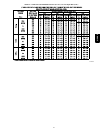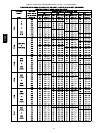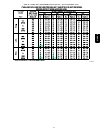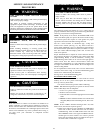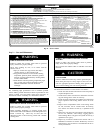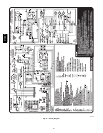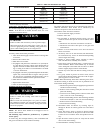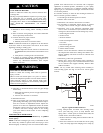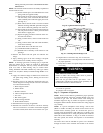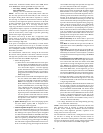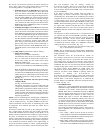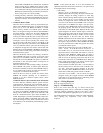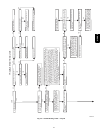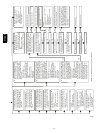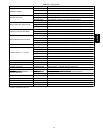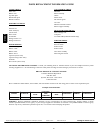
52
from COOL to HI HEAT for a maximum of 10 minutes
before reverting back to COOL speed. If there is still a
demand for dehumidification after 20 minutes, the fur-
nace control CPU will drop the blower speed back to HI
HEAT speed. This alternating 10--minute cycle will con-
tinue as long as there is a call for cooling.
c. Cooling off--delay -- When the “call for cooling” is satis-
fiedandthereisademand fordehumidification,thecool-
ing blower--off delay is decreased from 90 seconds to 5
seconds.
5. Continuous Blower Mode
When the R--to--G circuit is closed by the thermostat, the
blower motor BLWM will operate on continuous--blower
speed (can be set to LO HEAT, HI HEAT, or COOL
speed). Factory default is LO HEAT speed. Terminal
EAC--1 is energized as long as the blower motor BLWM is
energized. During a call for heat, the blower BLWM will
stop during igniter warm--up (17 seconds), ignition (7
seconds), and blower--ON delay (45 seconds in low--heat,
and 25 seconds in high--heat), allowing the furnace heat
exchangers to heat up more quickly, then restarts at the
end of the blower--ON delay period at LO HEAT or HI
HEAT speed respectively. The blower motor BLWM will
revert to continuous--blower speed after the heating cycle
is completed. In high--heat, the furnace control CPU will
hold the blower motor BLWM at HI HEAT speed during
the selected blower--OFF delay period before reverting to
continuous--blower speed.
When the thermostat “calls for low--cooling”, the blower
motor BLWM will switch to operate at low--cool speed
(same speed as LO HEAT). When the thermostat is satis-
fied, the blower motor BLWM will operate an additional
90 seconds on low--cool speed before reverting back to
continuous--blower speed.
When the thermostat “calls for high--cooling”, the blower
motor BLWM will operate at COOL speed. When the
thermostat is satisfied, the blower motor BLWM will oper-
ate an additional 90 seconds on COOL speed before re-
verting back to continuous--blower speed.
When the R--to--G circuit is opened, the blower motor
BLWM will continue operating for an additional 5
seconds, if no other function requires blower motor
BLWM operation.
Continuous Blower Speed Selection from Thermostat
To select different continuous--blower speeds from the
room thermostat, momentarily turn off the FAN switch or
push button on the room thermostat for 1--3 seconds after
the blower motor BLWM is operating. The furnace control
CPU will shift the continuous--blower speed from the fact-
ory setting of LO HEAT to HI HEAT speed. Momentarily
turning off the FAN switch again at the thermostat will
shift the continuous--blower speed from HI HEAT to
COOL. Repeating the procedure will shift the continuous--
blower speed from COOL to LO HEAT speed. The selec-
tion can be changed as many times as desired and is stored
in the memory to be automatically used following a power
interruption.
NOTE: If the blower--off delay is set to the maximum, the
adjustable continuous--fan feature is locked (i.e., fan speed cannot
be changed from its current setting).
6. Heat Pump
(See Fig. 27--30 for thermostat connections)
When installed with a heat pump, the furnace control auto-
matically changes the timing sequence to avoid long
blower off times during demand defrost cycles. When the
R--to-- W/W1--and--Y1 or R--to--W/W1--and--Y1--and--G
circuits are energized the furnace control CPU will switch
to or turn on the blower motor BLWM at low--cool speed
(same speed as LO HEAT), and begin a low--heat cycle.
The blower motor BLWM will remain on until the end of
the prepurge period, then shut off for 24 seconds then
come back on at LO HEAT speed. When the W/W1 input
signal disappears, the furnace control begins a normal in-
ducer post--purge period and the blower remains running
at LO HEAT speed. If the R--to-- W/W1--and--Y1--and--G
signals disappear at the same time, the blower motor
BLWM will remain on for the selected blower-- OFF delay
period. If the R--to--W/W1--and--Y1 signals disappear,
leaving the G signal, the blower motor BLWM will remain
on for the selected blower--OFF delay period then switch
to continuous--blower speed.
When the R--to--W/W1--and--Y/Y2, R--to--W/W1--and--
Y / Y 2 -- a n d -- G , R -- t o -- W / W 1 -- a n d -- Y 1 -- a n d -- Y / Y 2 , o r
R--to--W/W1--and-- Y1--and--Y/Y2--and--G circuits are en-
ergized the furnace control CPU will switch to or turn on
the blower motor BLWM at COOL speed, and begin a
high--heat cycle. The blower motor BLWM will remain on
until the end of the prepurge period, then shut off for 24
seconds then come back on at HI HEAT speed. When the
W/W1 input signal disappears, the furnace control begins
a normal inducer post--purge period and the
blower switches to COOL speed after a 3 second delay. If
t h e R -- t o -- W / W 1 -- a n d -- Y / Y 2 -- a n d -- G o r R -- t o -- W / W 1 -- a n d
--Y1--and-- Y/Y2--and--G signals disappear at the same
time, the blower motor BLWM will remain on for the se-
lected blower--OFF delay period. If the R--to--W/W1--
a n d -- Y / Y 2 o r R -- t o -- W / W 1 -- a n d -- Y 1 -- a n d -- Y / Y 2 s i g n a l s
disappear, leaving the G signal, the blower motor BLWM
will remain on for the selected blower-- OFF delay period
then switch to continuous--blower speed.
Step 4 — Wiring Diagrams
Refer to wiring diagram, Fig. 52.
Step 5 — Troubleshooting
Refer to the service label. (See Fig. 51—Service Label.) The
Troubleshooting Guide can be a useful tool in isolating furnace
operation problems. Beginning with the word “Start,” answer
each question and follow the appropriate arrow to the next item.
The Guide will help to identify the problem or failed component.
After replacing any component, verify correct operation
sequence.
312AAV



